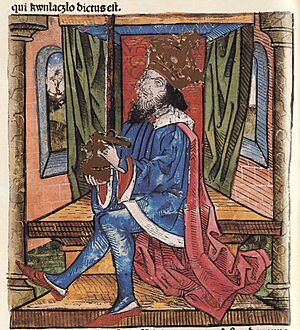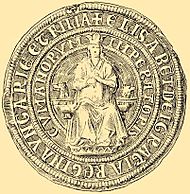Ladislaus IV of Hungary facts for kids
Quick facts for kids Ladislaus IV |
|
|---|---|

Ladislaus the Cuman's seal
|
|
| King of Hungary and Croatia | |
| Reign | 6 August 1272 – 10 July 1290 |
| Coronation | August 1272, Székesfehérvár |
| Predecessor | Stephen V |
| Successor | Andrew III |
| Born | 5 August 1262 |
| Died | 10 July 1290 (aged 27) Körösszeg (Cheresig), Kingdom of Hungary |
| Burial | Cathedral of Csanád (Cenad, Romania) |
| Spouse |
Elizabeth of Sicily
(m. 1270) |
| Dynasty | Árpád |
| Father | Stephen V of Hungary |
| Mother | Elizabeth the Cuman |
| Religion | Roman Catholic |
Ladislaus IV (Hungarian: IV. (Kun) László, Croatian: Ladislav IV. (Kumanac), Slovak: Ladislav IV. (Kumánsky)), also known as Ladislaus the Cuman, was the King of Hungary and Croatia from 1272 to 1290. He was born on August 5, 1262. His mother, Elizabeth, was the daughter of a leader from the Cumans. The Cumans were a group of people who had settled in Hungary.
When Ladislaus was seven, he married Elisabeth, who was the daughter of King Charles I of Sicily. Ladislaus was only nine years old when a powerful lord named Joachim Gutkeled kidnapped him.
Ladislaus was still held captive when his father, Stephen V, died on August 6, 1272. During Ladislaus's younger years, many powerful families, like the Abas and Csáks, fought for control of Hungary. In 1277, when he was 15, Ladislaus was declared old enough to rule on his own.
He teamed up with Rudolf I of Germany against Ottokar II of Bohemia. Ladislaus's army played a big part in Rudolf's victory at the Battle on the Marchfeld in 1278.
However, Ladislaus found it hard to bring back strong royal power in Hungary. A church leader, Philip, the bishop of Fermo, came to Hungary to help. But he was surprised to see many pagan Cumans living there. Ladislaus promised to make them adopt a Christian way of life. But the Cumans refused. Ladislaus then chose to support the Cumans. Because of this, Bishop Philip removed Ladislaus from the church. The Cumans then captured the bishop, and the bishop's friends captured Ladislaus. In 1280, Ladislaus agreed to try and convince the Cumans to follow the bishop's rules. Many Cumans chose to leave Hungary instead.
Ladislaus defeated a Cuman army that attacked Hungary in 1282. Hungary also survived a Mongol invasion in 1285. By this time, Ladislaus was not very popular. Some people even blamed him for the Mongol invasion. In his last years, he traveled with his Cuman friends. He could no longer control the most powerful lords and bishops. Pope Nicholas IV was planning to start a holy war against him. But three Cuman attackers murdered Ladislaus on July 10, 1290.
Contents
Early Life (1262–1272)
Ladislaus was the older son of Stephen V and his wife, Elizabeth the Cuman. His grandfather was Béla IV of Hungary. Elizabeth was the daughter of a Cuman leader. She was born pagan but was baptized before she married Stephen. Ladislaus was born in 1262.
Conflicts between Ladislaus's father and grandfather led to a civil war in 1264. Troops loyal to Ladislaus's grandfather captured the castle where Ladislaus and his mother were staying. They were taken prisoner. Ladislaus was later sent to the court of Bolesław V the Chaste, the Duke of Cracow. After his grandfather and father made peace in March 1265, Ladislaus was set free and returned to his father.
In 1269, Ladislaus's father made an alliance with King Charles I of Sicily. As part of this agreement, Charles I's daughter, Elizabeth, was engaged to Ladislaus. She was about four, and he was seven. Their marriage took place in 1270.
Ladislaus's father became king in May 1270. However, he struggled to keep control. Some powerful people turned against him. In the summer of 1272, Joachim Gutkeled kidnapped Ladislaus. Gutkeled held Ladislaus captive in a fortress. Stephen V tried to rescue his son but couldn't. Stephen became very ill and died on August 6.
Becoming King
Challenges as a Young King (1272–1277)
When Stephen V died, Joachim Gutkeled quickly went to Székesfehérvár. He wanted to make sure the young Ladislaus was crowned king. Ladislaus's mother joined him. This made some of Stephen V's supporters angry. They thought she had worked against her husband.
Archbishop Philip of Esztergom crowned Ladislaus king around September 3. Ladislaus was only 10 years old. His mother was supposed to rule for him, but in reality, different groups of powerful lords controlled the kingdom.
In 1273, Austrian and Moravian troops attacked Hungary. They captured towns and plundered the western areas. Joachim Gutkeled recaptured some forts, but Ottokar II of Bohemia invaded and took many more.
Different groups of lords kept fighting for power. Ladislaus was sometimes captured by one group, then freed by another. He even joined military campaigns with some of these lords. In 1274, Ladislaus made an alliance with Rudolf I of Germany against Ottokar II of Bohemia.
Ladislaus became very sick but recovered. He believed his recovery was a miracle from his saintly aunt, Margaret. He asked the Pope to make her a saint. In 1276, more fighting broke out among the lords.
Ruling on His Own (1277–1278)
In April 1277, Joachim Gutkeled died in battle. A month later, an important meeting of church leaders, lords, and noblemen declared Ladislaus old enough to rule. He was 15 years old. They gave him permission to bring peace back to Hungary.
Ladislaus tried to defeat rebellious lords in Transdanubia but couldn't. He met with Rudolf I of Germany in November to confirm their alliance against Ottokar II of Bohemia.
In 1278, Ladislaus held a large meeting for several counties. They condemned two rebellious noblemen to death. Ladislaus then joined forces with Rudolf I of Germany against Ottokar II. Ladislaus's troops were very important in Rudolf's victory at the Battle on the Marchfeld on August 26. Ottokar was killed in the battle. After the battle, King Rudolf I thanked Ladislaus greatly for his help.
The Cuman Challenge (1278–1285)
Pope Nicholas III sent Bishop Philip of Fermo to Hungary in 1278 to help Ladislaus strengthen his rule. Bishop Philip arrived in early 1279. He soon saw that most Cumans in Hungary still followed their pagan beliefs. He made the Cuman leaders promise to give up their old customs. He also made Ladislaus swear an oath to make sure the Cumans kept their promise.
New laws were made that said Cumans should live in houses, not tents. But the Cumans did not obey. Ladislaus, who was half-Cuman himself, did not force them. Because of this, Bishop Philip removed Ladislaus from the church and placed Hungary under a ban. Ladislaus then sided with the Cumans.
In January 1280, the Cumans, at Ladislaus's request, captured Bishop Philip. However, a powerful lord named Finta Aba then captured Ladislaus. In less than two months, both the bishop and the king were set free. Ladislaus promised again to enforce the Cuman laws. But many Cumans decided to leave Hungary instead. Ladislaus tried to stop them but couldn't.
In 1282, a Cuman army attacked southern Hungary. Ladislaus led his army against them. He defeated the invaders at Lake Hód in the autumn of 1282.
By the end of 1283, Ladislaus had left his wife, Isabella, and was living among the Cumans.
Later Years (1285–1290)
In January 1285, the Mongols from the Golden Horde invaded Hungary. They caused great destruction, especially east of the Danube River. The invasion lasted for two months before the Mongols left.
Ladislaus's preference for the Cumans made him very unpopular. Some people even accused him of encouraging the Mongols to invade Hungary. Ladislaus liked the Cuman way of life, including their clothes and hairstyles.
In September 1286, Ladislaus imprisoned his wife. Archbishop Lodomer freed the queen a year later. The archbishop then gathered church leaders and lords and removed Ladislaus from the church. Ladislaus was very angry.
In January 1288, some lords captured Ladislaus. His supporters soon freed him. He agreed to make peace with Archbishop Lodomer. The archbishop allowed Ladislaus back into the church, but only if he lived a Christian life. However, Ladislaus broke his promise.
Ladislaus spent his last years traveling around the country. The central government of Hungary lost power. Powerful church leaders and lords ruled parts of the kingdom on their own. For example, the Kőszegi family fought wars against Albert I, the Duke of Austria. Ladislaus did not get involved, even though the Austrians captured many fortresses.
The Kőszegi family offered the crown to Andrew the Venetian. Andrew arrived in Hungary in early 1290. However, one of their enemies captured Andrew and handed him over to Duke Albert. Ladislaus appointed Mizse, who had recently become Christian, as a high official. Pope Nicholas IV was even planning a holy war against Ladislaus.
However, Ladislaus, who had always favored his Cuman subjects, was murdered by three Cumans named Arbuz, Törtel, and Kemence. This happened at the castle of Körösszeg (now Cheresig in Romania) on July 10, 1290. Mizse and another Cuman named Nicholas (who was the brother of Ladislaus's Cuman friend) got revenge for Ladislaus's death. They killed the murderers.
The Pope ordered an investigation to find out if Ladislaus died as a Catholic Christian. The results are not known. But the Chronicon Budense says Ladislaus was buried in the cathedral of Csanád (now Cenad in Romania). His successor, Andrew the Venetian, and Pope Benedict VIII remembered Ladislaus as "of renowned memory."
See also
 In Spanish: Ladislao IV de Hungría para niños
In Spanish: Ladislao IV de Hungría para niños
- Maria of Hungary (1257–1323)
- Elizabeth the Cuman
- Cuman people
- Cumania
Sources
Primary sources
- Simon of Kéza: The Deeds of the Hungarians (Edited and translated by László Veszprémy and Frank Schaer with a study by Jenő Szűcs) (1999). CEU Press. ISBN: 963-9116-31-9.
- The Hungarian Illuminated Chronicle: Chronica de Gestis Hungarorum (Edited by Dezső Dercsényi) (1970). Corvina, Taplinger Publishing. ISBN: 0-8008-4015-1.
Secondary sources
- Fine, John Van Antwerp (1994). [Ladislaus IV of Hungary at Google Books The Late Medieval Balkans: A Critical Survey from the Late Twelfth Century to the Ottoman Conquest]. Ann Arbor, Michigan: University of Michigan Press. ISBN 0-472-08260-4. Ladislaus IV of Hungary at Google Books.
- Treadgold, Warren (1997). [Ladislaus IV of Hungary at Google Books A History of the Byzantine State and Society]. Stanford, California: Stanford University Press. ISBN 0-8047-2630-2. Ladislaus IV of Hungary at Google Books.
|
Ladislaus IV of Hungary
House of Árpád
Born: 1262 Died: 10 July 1290 |
||
| Regnal titles | ||
|---|---|---|
| Preceded by Stephen V |
King of Hungary and Croatia 1272–1290 |
Succeeded by Andrew III |




